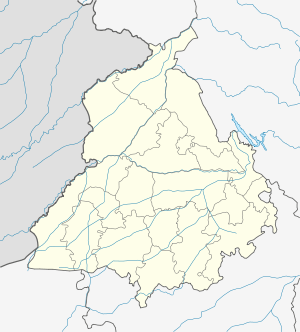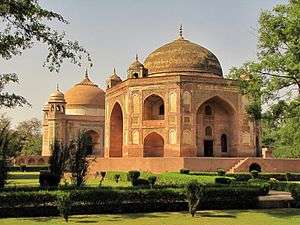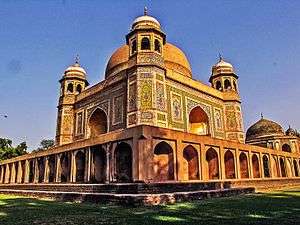Nakodar
| Nakodar | |
|---|---|
| city | |
 Nakodar Location in Punjab, India | |
| Coordinates: 31°08′N 75°28′E / 31.13°N 75.47°ECoordinates: 31°08′N 75°28′E / 31.13°N 75.47°E | |
| Country |
|
| State | Punjab |
| District | Jalandhar |
| Population (2001) | |
| • Total | 31,422 |
| Languages | |
| • Official | Punjabi |
| Time zone | IST (UTC+5:30) |
| Website |
jalandhar |
Nakodar (Punjabi: ਨਕੋਦਰ, Hindi: नकोदर, pronounced Nuh-Koh-Durh) is a city and a municipal council in Jalandhar district in the Indian state of Punjab.
The city is almost 365 km from Delhi, 25 km from Jalandhar, 49 km from Ludhiana, and about 101 km from Amritsar. Surrounding villages include Chak Mughlani, Maheru, Allowal, Mehatpur (Hari pur) (Bhullar) Nawan Pind Jattan, Heran, Bir Pind, Shankar, Nur Pur Chatha, Sarih, Malri and Khanpur Dhadda.
The town is well pave and has thriving appearances and currently forms a Tehsil of District Jalandhar. Outside the town, there are two large and handsome tombs dating at least from the times of Emperor Jahangir, later one of them is said to be the burial place of the adviser of Emperor Shah Jahan, but it is not known who stand buried in the earlier tomb.
Origin of name
The name Nakodar, according to one account, is a said to be derived from the Persian words Neki ka dar, which mean Gate of Goodness or Virtue and it was named so by the Persian Kambohs. According to another version, the town was so-named after Nikudari legion of the Mongols.[1]
History


The Town is of considerable antiquity and had been held in succession by three different races, the JATTS, Kambohs( Kamboj) and then by the muslim Rajputs, traces of whom still exist in the extensive ruins by which the town is surrounded. The town was anciently founded by the Hindu Kamboh, according to Sir William Wilson Hunter and others.[2][3][4][5][6][7] The Kamboh settlements lay to the west of present town and the sites are still marked by extensive ruins and two old fine tombs, now called the Black and Red Domes, from the color of the material. Tradition attributes the Kamboh expulsion to the Nawab Kutb Khan who came with an army from Indor near Nuh in 1570 AD.[2] As a consequence, the lordship of the town thus passed over to the Khanzadaas from the Kamboj tribe. Within two generations, the Rajputs got the town in jagir from Emperor Jahangir, in later sixteenth century, apparently divesting the Khanzadahs, the successor race to the Kambohs. The Rajputs were themselves later ousted during Sikh period by one Sardar Tara Singh Ghaiba who made a fort and made himself the master of the surroundings. From Ghaiba, the town was seized by Maharaja Ranjit Singh in 1816.
Geography
Nakodar is located at 31°08′N 75°28′E / 31.13°N 75.47°E.[8] It has an average elevation of 223 metres (731 feet).
Demographics
As of 2011 India census,[9] Nakodar had a population of 36973 . Males constitute 53% of the population and females 47%. Nakodar has an average literacy rate of 84.2%, the national average is of 74.4%: male literacy is 87.4%, and female literacy is 80.3 . In Nakodar, 11% of the population is under 6 years of age.
Places of interest
Popular Religious Places
. Kutia Sant Dalel Singh ji Maharaj Baradari
- Dera Baba Murad Shah Ji
- Dera Baba Lal Badshah ji
- Sai Ladi Shah Ji
- Darbar Peer Mouju Shah Ji
- Naag Wali Peer Baba Jaffe Shah Ji ( Sundar Nagar, Nakodar)
- Baba Mall Ji Malri Sahib Gurdwara
- Darbar Brahm Jogi Bapu ji Maharaj
- Nawa Nanaksar Thath, Balanda
- Jagdambey Dham (Devi Talab Mandir)
- Sri Sudarshan Mandir
- Gugga Jahar Pir Ji Mandir
- Malri Sahib Gurudwara
- Nanaksar Sahib Gurudwara
- Mata Jamba Jain Mandir
- Mata Chakarshvari Davi Jain Mandir
- AadiNath Jain Mandir
- Nanaksar Sahib, (Ballan wala)
- Pracheen Shivalaya Mandir 2913 Katra Missran, Nakodar
- Jagan Nath Mandir (Baba Charen Das)
- Jagga Baba Ji (Mohalla Dhiran)
. Kutia shri 108 Sant Ramanand jI , Moh: Guru Ravidasspura, Nakodar (Sewadar Shri Mandeep Dass ji) Branch of Dera Sachkhand Ballan
- kutia Shri mann 108 sant baba dalel singh ji maharaj ( baaradari ) malri road , nakodar...
Education
Colleges in Nakodar
- K.R.M.D.A.V. College
- Guru Nanak National College
- Satyam Institute of Management and Technology
- P.S Technical Institute of Industrial Training
Schools in Nakodar
- Cambridge International school
- State Public School
- St. Jude's Convent School
- Guru Nanak National Public School
- Sewak Public School
- Kidsvilla Kindergarten School
- Tagore Model Sr. Sec. School
- M.D.Dayanand Model School
- New Janta Model Sr. Sec. School
- A.S.Sr.Sec. School (Arya School)
- Apex International Public School
- Amarjot Sandhu School of Chemistry
- Indo-Swiss International School
- Ram Garhia Model High School
- Bhartiya Gopal Model High School
- Saraswati Model High School
Notable people
Nakodar is home to many popular Punjabi lyricists And Singers like Kaler Kanth, K.S Makhan, Lehmber Hussainpuri, Vijay Dhammi, Gurdas Mann, Hans Raj Hans, Malkit Singh, Garry Sandhu. It is also the birthplace of world famous poet, Yuyutsu Sharma. In addition, late poet Padam Shree Pandit Labhu Ram Josh Malsiyani was also born here and spent most of his life in the town. His poem Nagma-e-Josh can be read at the entrance to the town near Bus stop and his son, Arsh Malsiyani is also a poet in Urdu. Other poets like Hindi poet Mohan Sapra, and Punjabi poets like Veerendra Parihar, Bhupendra Parihar and Amritjit Chandan have also lived in this town. In the modern days, first MLA of independent India's state assembly member was Comrade Harkishan Singh Surjeet. Other famous people comrade Varinder Kumar Gagan and Surjit Singh Sherpur were killed by mental Deepa from nearby village Heran while working for drug smuggler Bhag from village Garha during crime rich Khalistan movement of 1980s. Deepa was killed by authorities at Bhag's house at village Garha along with a few other criminals.
References
- ↑ Journal of Asiatic Society of Bengal, Vol. LXI, p.298 .
- 1 2 Punjab gazetteers, 1883, bound in 10 vols., without title-leaves, 1883, p 159, Punjab
- ↑ Punjab District Gazetteers, 1970, p 496, Punjab (India).
- ↑ Imperial Gazetteer of India, 1886, p 180, Sir William Wilson Hunter.
- ↑ Gazetteer Jalandhar, First Edition, 1980, Chapter XIX, Places of Interest.
- ↑ See also the link:.
- ↑ Encyclopedia of Jalandhar: Jalandhar, 2004, p 38, Harajindar Siṅgha Dilagīr.
- ↑ Falling Rain Genomics, Inc - Nakodar
- ↑ "Census of India 2001: Data from the 2001 Census, including cities, villages and towns (Provisional)". Census Commission of India. Archived from the original on 2004-06-16. Retrieved 2008-11-01.
- Encyclopaedia of Jalandhar, 2004, Harjinder Singh Dilgeer (Also see his The SIKH REFERENCE BOOK).
- Imperial Gazetteer of India, 1886, Sir William Wilson Hunter;
- Punjab gazetteers, 1883, bound in 10 vols., without title-leaves, 1883, Punjab.
- Gazetteer Jalandhar,First Edition, 1980, Chapter XIX, Places of Interest(Nakodar).
- http://pbhealth.gov.in/maps/jal/MEHATPUR.pdf
External links
- Online tour/ pictures of Dera Baba Murad Shah Ji, Nakodar
- NakodarCity.Com
- Nakodar@Punjab Revenue
- Official website of Jalandhar district
- Wikimapia - Prominent Locations in Nakodar
- Boparai Kalan, Nakodar (Official)